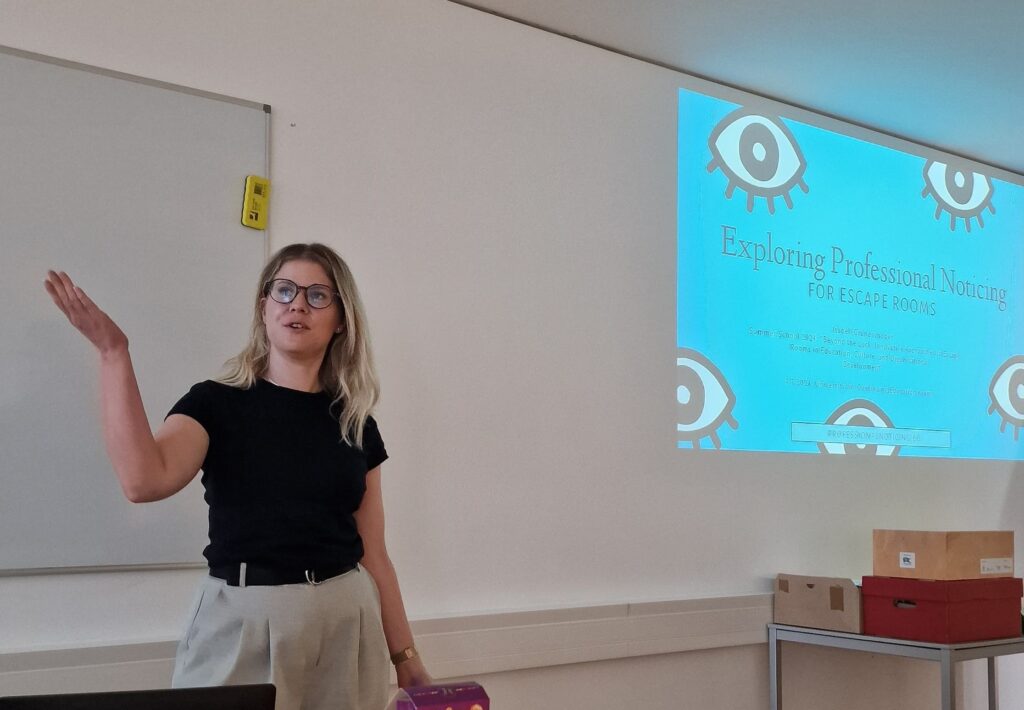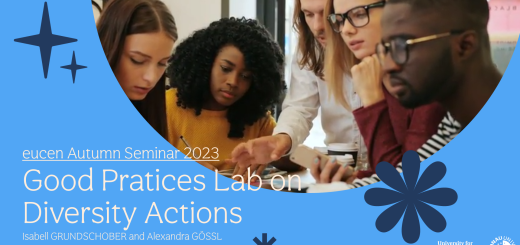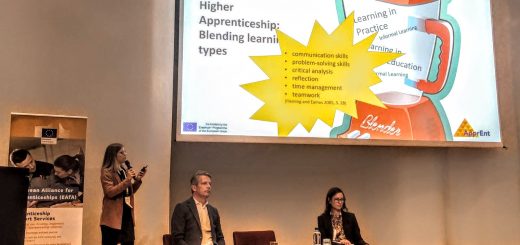Unlocking Professional Noticing through AI-Driven Escape Rooms
When I first presented at the Escape Room Summer School 2024 at the University for Continuing Education, I had a vision: to explore how professional noticing is connected to escape room dynamics. Though we weren’t physically navigating locks and keys, our session was an explorative journey into the mechanics of how these playful simulations can teach critical professional skills.

The Escape Room as a Microcosm for Learning
Professional noticing, as Rooney & Boud (2019) explain, involves the ability to identify and interpret key aspects of a situation – a skill vital in many professions but often challenging to develop in traditional training environments. They highlighted that simulations are crucial in helping novices build this ability. Escape rooms, with their complex puzzles and dynamic group interactions, have great potential to provide a compelling simulation of professional challenges. They engage participants in a playful yet intense environment, fostering a natural development of noticing skills.
In our session, we discovered how escape room dynamics could enhance professional skills. The clues and puzzles could be designed similarly to real-world problems, requiring keen observation, critical thinking, and collaborative effort to solve. Each hint, each piece of the puzzle, represents a fragment of the information professionals must notice and interpret in their daily tasks.
Insights from Céline Neubig’s Research
During the summer school, I was particularly captivated by the findings of Céline Neubig’s master thesis, “Unlocking Knowledge: Was edukative Escape Rooms von den weltbesten Räumen lernen können.” Her research provides valuable insights into how educational escape rooms can be designed to enhance learning experiences. Neubig’s work emphasizes the importance of immersion, storytelling, and well-crafted puzzle design in creating effective educational escape games. She highlights that educational escape games often fall short of their potential by not fully utilizing these elements.
Neubig’s detailed analysis of 38 top-rated escape rooms revealed significant patterns in game mechanics, puzzle typology, and narrative structures that can be applied to educational settings. These patterns include the effective use of narrative engagement to draw players into the game world and the strategic placement of puzzles to maintain a balance between challenge and player skill. This approach ensures that players remain engaged and can achieve a state of flow, enhancing their learning experience.
The Power of Storytelling in Escape Rooms
In a truly inspiring workshop titled “How to Value an Object – Stories and Riddles Behind a Tomato Can” Klaus Neundlinger from the Institute for Cultural Excellence Research and story consultant Ines Häufler underlined the power of storytelling in escape room games. They emphasized that compelling narratives answer the question “Why should I care?” and find emotional motives that support the escape game’s story. Developing stories with them was a transformative experience, highlighting how emotional engagement can significantly enhance the learning and noticing process in escape rooms.
Survey Insights on Overlooked Elements in Escape Rooms
To deepen our understanding, I conducted a survey via Mentimeter during the summer school, asking participants what they failed to notice while playing escape room games. The responses highlighted various aspects of the escape room experience that were often overlooked:
- Hidden Clues, Puzzle Solving, and Unnoticed Details (13 responses)
- Hidden clues
- Codes written in unexpected places
- An open door that wasn’t noticed
- A padlock that wasn’t found
- Additional rooms that weren’t discovered
- Invisible ink
- The location of a bathroom
- Solutions to puzzles that were solved quickly
- Numbers hidden in flowers
- Social Interaction and Teamwork (7 responses)
- How players talked to each other
- Other people communicating
- Social dynamics within the team
- Basic needs during the game
- The thoughts of other players
- Time Passing (3 responses)
- The passage of time during the game
- The effort required to move further
- Knowing when to progress to the next stage
These insights reveal common themes in what players often miss during escape room games, including hidden physical clues, social interactions, time management, and teamwork dynamics. Understanding these overlooked elements can help in designing more effective and engaging escape room experiences. Time pressure and high cognitive load, lack of experience, knowledge, or skills, or a lack of willingness to notice (due to biases or cognitive dissonance for example) can prevent people from noticing.
Enhancing Noticing in Escape Room Dynamics
Noticing critical details in escape rooms can be challenging, but certain elements and strategies can significantly improve players’ ability to detect and interpret important cues. In the break, I chatted with Corinna Stiefelbauer from the University for Continuing Education Vienna and she asked me if Mayer’s Principles of Multimedia Learning could be integrated to further enhance noticing in the escape game dynamics. I think that’s a great question and here are some first thoughts on how escape room dynamics help to notice and how it could be related to Mayer’s Principles:
- Group Collaboration
- Diverse Perspectives: Working in a group allows players to pool their different perspectives and cognitive approaches, increasing the likelihood of noticing varied details.
- Communication: Effective communication within the team helps ensure that important observations are shared and discussed, reducing the chance of missing crucial clues.
- Environmental Design
- Highlighting Key Elements: Using colors, lighting, and sound to draw attention to important areas or objects can guide players to notice them. This aligns with Mayer’s Signaling Principle, which suggests that people learn better when cues highlight the organization of the essential material.
- Clutter Reduction: Keeping the environment relatively uncluttered can help players focus on the relevant details without being overwhelmed by unnecessary distractions, supporting Mayer’s Coherence Principle that learners perform better when extraneous material is excluded.
- Hint Systems
- Contextual Hints: Providing hints that nudge players towards overlooked elements without giving away the solution can help maintain engagement while directing attention to missed details.
- Timed Hints: Implementing a system where hints are given after a certain period of inactivity or lack of progress can help refocus players on what they might have missed.
- Narrative Integration
- Storytelling: Embedding clues within the narrative can make them more memorable and easier to notice. Mayer’s Personalization Principle indicates that people learn better when words are conversational rather than formal, which can make the narrative more engaging.
- Role-Playing: Assigning specific roles or tasks within the narrative can help ensure that different aspects of the environment are examined closely by different team members.
- Training and Preparation
- Pre-Game Briefing: Providing players with a clear briefing that includes tips on what types of clues to look out for and common hiding spots can prime them to notice important details, adhering to Mayer’s Pre-training Principle which suggests that people learn better when they receive pre-training in the names and characteristics of the main concepts.
- Practice Puzzles: Offering a few practice puzzles before the main game can help players get into the right mindset and develop a sharper eye for noticing details.
- Feedback Mechanisms
- Immediate Feedback: Systems that provide immediate feedback when players interact with key elements can help reinforce the importance of these elements and guide future noticing. Mayer’s Feedback Principle indicates that learners benefit from receiving explanatory feedback on their performance.
- Post-Game Debrief: Reviewing what was missed and why after the game can help players learn and improve their noticing skills for future experiences.
- Interactive Elements
- Physical Engagement: Requiring players to physically interact with the environment can make them more likely to notice details. For example, moving objects or solving physical puzzles can reveal hidden clues.
- Multi-Sensory Cues: Incorporating auditory, tactile, and even olfactory cues in addition to visual clues can help engage different senses and make important details more noticeable, supporting Mayer’s Multimedia Principle which states that people learn better from words and pictures than from words alone.
- Structured Search Patterns
- Systematic Searching: Encouraging players to search the room systematically, such as dividing it into sections or following a specific order, can ensure that no area is overlooked.
By incorporating these elements, enhanced by Mayer’s Principles of Multimedia Learning, into escape room design, creators can significantly improve players’ ability to notice and interpret critical details, leading to a more engaging and educational experience.
The Role of AI in Crafting Immersive Learning Experiences
The rise of generative AI provides new chances for creating virtual escape rooms. Generative AI can design detailed puzzles, adapt challenges in real-time based on participants’ actions, and provide tailored feedback – all elements that could enhance the learning experience. However, it’s important to note that while the technology is promising, its application in virtual escape rooms is still evolving.
Imagine a virtual escape room designed to train medical professionals. AI could simulate a hospital environment, with puzzles and clues related to patient care, diagnostic processes, and emergency response. As participants navigate the room, the AI monitors their actions, adjusting the difficulty and providing hints that guide them toward key learning outcomes. This dynamic interaction not only keeps participants engaged but also reinforces the professional noticing skills they need in simulation scenarios.
From Puzzles to Professional Mastery
Incorporating generative AI in escape room design allows us to push the boundaries of traditional training methods. It transforms learning into an interactive, immersive experience that captures the complexity of professional tasks. For HR professionals in learning and development, this approach offers a novel way to equip employees with essential skills.
To illustrate, consider a company looking to improve its customer service training. A virtual escape room could simulate various customer interactions, from handling complaints to upselling products. Employees would need to notice subtle cues, interpret customer needs, and respond appropriately, all within the engaging context of solving puzzles and escaping the room. This simulation not only enhances their noticing skills but also builds confidence and competence in a controlled, risk-free environment.
Crafting the Future of Learning
As we continue to explore the potential of AI in creating immersive learning environments, the possibilities are boundless. Virtual escape rooms can be customized for any profession, providing tailored simulations that address specific learning objectives. By blending the excitement of game dynamics with the rigor of professional training, we can foster a pedagogy of professional noticing that is both effective and engaging.
Our journey at the Escape Room Summer School, complemented by insights from Céline Neubig’s research and the survey results, highlighted the transformative power of escape rooms in professional development. With the integration of generative AI, we are poised to unlock new dimensions in learning and development, crafting experiences that teach and inspire. For HR professionals, this represents a frontier of innovation, where learning is no longer a passive process but an active, thrilling adventure.
What do you think?
How can escape room dynamics and AI be integrated into your organization’s professional development programs? Share your thoughts and experiences leveraging innovative learning methods to enhance professional noticing and overall performance! Please leave a comment under this blogpost 🙂
Literature & Links
- PROMISE EU – the EU project on professional noticing in entrepreneurship education
- Celiné’s master thesis: Unlocking Knowledge: Was edukative Escape Rooms von den weltbesten Räumen lernen können
- Rooney & Boud (2019) on developing a pedagogy of professional noticing
- Mayer’s Principles of Multimedia Learning in game-based learning
- One Useful Thing – Blog von Ethan Mollick
- Navigating the Jagged Technological Frontier: Field Experimental Evidence of the Effects of AI on Knowledge Worker Productivity and Quality
- Professional Noticing in Entrepreneurship – a Starter Kit to build PN Skills in entrepreneurship education


